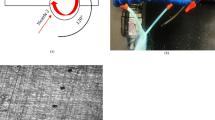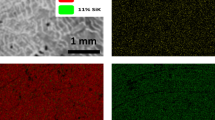Abstract
The increasing environmental and health concerns of conventional emulsion flood coolants have motivated the use of vegetable oil in the form of minimum quantity lubrication (MQL) in machining. This paper presents comparative evaluation of high oleic soybean oil (HOSO)–based MQL flow rates at 10, 30, 50, 70, and 90 ml/h with a mineral oil–based emulsion flood coolant as a benchmark in face milling of Inconel 718 using AlTiN/TiN-coated carbide inserts. Cutting forces, tool wear, and surface roughness were measured and analyzed. The results show that MQL oil flow rate at 70 ml/h gave the longest tool life comparable to that of mineral oil–based emulsion flood cooling, while 10 ml/h flow rate gave the shortest tool life. Also, 70 ml/h flow rate gave the lowest resultant cutting force among all MQL oil flow rates and conventional emulsion cooling at tool life. Increasing HOSO-based MQL flow rate improves surface roughness and reduces tool wear by providing enough thin lubrication film but also leads to an increase in chip affinity and formation of large built-up edges (BUEs) as the MQL flow rate reaches 90 ml/h. At lower HOSO-based MQL flow rate, tool wear mechanism is predominantly abrasion due to large surface friction, while at higher HOSO-based MQL flow rate, tool wear mechanism is adhesion leading to excessive BUEs. HOSO-based MQL flow rate of 70 ml/h and air pressure of 4.14 bar are recommended when face milling Inconel 718 and are demonstrated to be a potential replacement of mineral oil–based conventional emulsion flood cooling strategy for machining of difficult-to-cut metals.












Similar content being viewed by others
References
Ezugwu EO, Bonney J, Yamane Y (2003) An overview of the machinability of aeroengine alloys. J Mater Process Technol
Ning J, Nguyen V, Liang SY (2019) Analytical modeling of machining forces of ultra-fine-grained titanium. Int J Adv Manuf Technol 101:627–636. https://doi.org/10.1007/s00170-018-2889-6
Okafor AC, Sultan AA (2016) Development of a mechanistic cutting force model for wavy-edge bull-nose helical end-milling of inconel 718 under emulsion cooling strategy. Appl Math Model 40:2637–2660. https://doi.org/10.1016/j.apm.2015.09.040
Ning J, Liang SY (2019) A comparative study of analytical thermal models to predict the orthogonal cutting temperature of AISI 1045 steel. Int J Adv Manuf Technol 102:3109–3119. https://doi.org/10.1007/s00170-019-03415-9
Kara F, Aslantaş K, Çiçek A (2016) Prediction of cutting temperature in orthogonal machining of AISI 316L using artificial neural network. Appl Soft Comput J 38:64–74. https://doi.org/10.1016/j.asoc.2015.09.034
Ezugwu EO, Bonney J (2004) Effect of high-pressure coolant supply when machining nickel-base, Inconel 718, alloy with coated carbide tools. J Mater Process Technol 153–154:1045–1050. https://doi.org/10.1016/j.jmatprotec.2004.04.329
Mia M, Ranjan N (2018) Effects of duplex jets high-pressure coolant on machining temperature and machinability of Ti-6Al-4V superalloy. J Mater Process Technol 252:688–696. https://doi.org/10.1016/j.jmatprotec.2017.10.040
Cetin MH, Ozcelik B, Kuram E, Demirbas E (2011) Evaluation of vegetable based cutting fluids with extreme pressure and cutting parameters in turning of AISI 304L by Taguchi method. J Clean Prod 19:2049–2056. https://doi.org/10.1016/j.jclepro.2011.07.013
Kumar K, Suvin PS, Vasu S, Ravi M (2019) Hard machining performance of indigenously developed green cutting fluid using flood cooling and minimum quantity cutting fl uid. J Clean Prod 206:108–123. https://doi.org/10.1016/j.jclepro.2018.09.178
Okafor AC, Jasra PM (2018) Effects of cooling strategies and tool coatings on cutting forces and tooth frequency in high-speed down-milling of Inconel 718 using helical bull-nose solid carbide end mills. Int J Adv Manuf Technol 97:2301–2318. https://doi.org/10.1007/s00170-018-2096-5
Kang MC, Kim KH, Shin SH et al (2008) Effect of the minimum quantity lubrication in high-speed end-milling of AISI D2 cold-worked die steel (62 HRC) by coated carbide tools. Surf Coat Technol 202:5621–5624. https://doi.org/10.1016/j.surfcoat.2008.06.129
Zhang S, Li JF, Wang YW (2012) Tool life and cutting forces in end milling Inconel 718 under dry and minimum quantity cooling lubrication cutting conditions. J Clean Prod 32:81–87. https://doi.org/10.1016/j.jclepro.2012.03.014
Liao YS, Lin HM (2007) Mechanism of minimum quantity lubrication in high-speed milling of hardened steel. Int J Mach Tools Manuf 47:1660–1666. https://doi.org/10.1016/j.ijmachtools.2007.01.007
Park KH, Suhaimi MA, Yang GD et al (2017) Milling of titanium alloy with cryogenic cooling and minimum quantity lubrication (MQL). Int J Precis Eng Manuf 18:5–14. https://doi.org/10.1007/s12541-017-0001-z
Hadad M, Sadeghi B (2013) Minimum quantity lubrication-MQL turning of AISI 4140 steel alloy. J Clean Prod 54:332–343. https://doi.org/10.1016/j.jclepro.2013.05.011
Sharma J, Sidhu BS (2014) Investigation of effects of dry and near dry machining on AISI D2 steel using vegetable oil. J Clean Prod 66:619–623. https://doi.org/10.1016/j.jclepro.2013.11.042
Kaynak Y (2014) Evaluation of machining performance in cryogenic machining of Inconel 718 and comparison with dry and MQL machining. Int J Adv Manuf Technol 72:919–933. https://doi.org/10.1007/s00170-014-5683-0
Shaikh VA, Scharf TW, Boubekri N (2017) Microlubrication machining of 1018 steel: the effect of a biodegradable lubricant on the microstructural integrity. Lubr Sci 29:357–376. https://doi.org/10.1002/ls.1373
Li KM, Lin CP (2012) Study on minimum quantity lubrication in micro-grinding. Int J Adv Manuf Technol 62:99–105. https://doi.org/10.1007/s00170-011-3789-1
Tawakoli T, Hadad MJ, Sadeghi MH (2010) Influence of oil mist parameters on minimum quantity lubrication - MQL grinding process. Int J Mach Tools Manuf 50:521–531. https://doi.org/10.1016/j.ijmachtools.2010.03.005
Sadeghi MH, Haddad MJ, Tawakoli T, Emami M (2009) Minimal quantity lubrication-MQL in grinding of Ti-6Al-4V titanium alloy. Int J Adv Manuf Technol. https://doi.org/10.1007/s00170-008-1857-y
Pervaiz S, Rashid A, Deiab I, Nicolescu CM (2016) An experimental investigation on effect of minimum quantity cooling lubrication (MQCL) in machining titanium alloy (Ti6Al4V). Int J Adv Manuf Technol 87:1371–1386. https://doi.org/10.1007/s00170-016-8969-6
Sharma AK, Tiwari AK, Dixit AR (2016) Effects of minimum quantity lubrication (MQL) in machining processes using conventional and nanofluid based cutting fluids: a comprehensive review. J Clean Prod 127:1–18
Okafor AC, Ertekin YM (2000) Vertical machining center accuracy characterization using laser interferometer. Part 1. Linear positional errors. J Mater Process Technol 105:407–420. https://doi.org/10.1016/S0924-0136(00)00662-2
Okafor AC, Nwoguh TO (2020) A study of viscosity and thermal conductivity of vegetable oils as base cutting fluids for minimum quantity lubrication machining of difficult-to-cut metals. Int J Adv Manuf Technol 106:1121–1131. https://doi.org/10.1007/s00170-019-04611-3
Rahim EA, Dorairaju H (2018) Evaluation of mist flow characteristic and performance in minimum quantity lubrication ( MQL ) machining. Measurement 123:213–225. https://doi.org/10.1016/j.measurement.2018.03.015
Maruda RW, Krolczyk GM, Feldshtein E et al (2016) A study on droplets sizes , their distribution and heat exchange for minimum quantity cooling lubrication (MQCL). Int J Mach Tools Manuf 100:81–92. https://doi.org/10.1016/j.ijmachtools.2015.10.008
Park K, Olortegui-yume J, Yoon M, Kwon P (2010) A study on droplets and their distribution for minimum quantity lubrication (MQL). Int J Mach Tools Manuf 50:824–833. https://doi.org/10.1016/j.ijmachtools.2010.05.001
Özbek O, Saruhan H (2020) The effect of vibration and cutting zonetemperature on surface roughness and tool wear ineco-friendly MQL turning of AISI D2. J Mater Res Technol. https://doi.org/10.1016/j.jmrt.2020.01.010
Funding
This study received financial support from the Intelligent System Center (ISC) at Missouri University of Science and Technology and financial assistance in the form of Graduate Teaching Assistantship by the Department of Mechanical and Aerospace Engineering at Missouri University of Science and Technology.
Author information
Authors and Affiliations
Corresponding author
Additional information
Publisher’s note
Springer Nature remains neutral with regard to jurisdictional claims in published maps and institutional affiliations.
Highlights
• HOSO-based MQL is a potential replacement to EC strategy in face milling Inconel 718.
• Tool life and surface roughness improve with increase in HOSO-based MQL flow rate.
• MQL oil flow rate at 70 ml/h gives optimum performance in high-speed face milling.
• MQL flow rates of 10 and 90 ml/h lead to rapid tool wear and thus not recommended.
• Increasing HOSO-based MQL flow rate leads to formation of excessive BUE at 90 ml/h.
Rights and permissions
About this article
Cite this article
Okafor, A.C., Nwoguh, T.O. Comparative evaluation of soybean oil–based MQL flow rates and emulsion flood cooling strategy in high-speed face milling of Inconel 718. Int J Adv Manuf Technol 107, 3779–3793 (2020). https://doi.org/10.1007/s00170-020-05248-3
Received:
Accepted:
Published:
Issue Date:
DOI: https://doi.org/10.1007/s00170-020-05248-3




